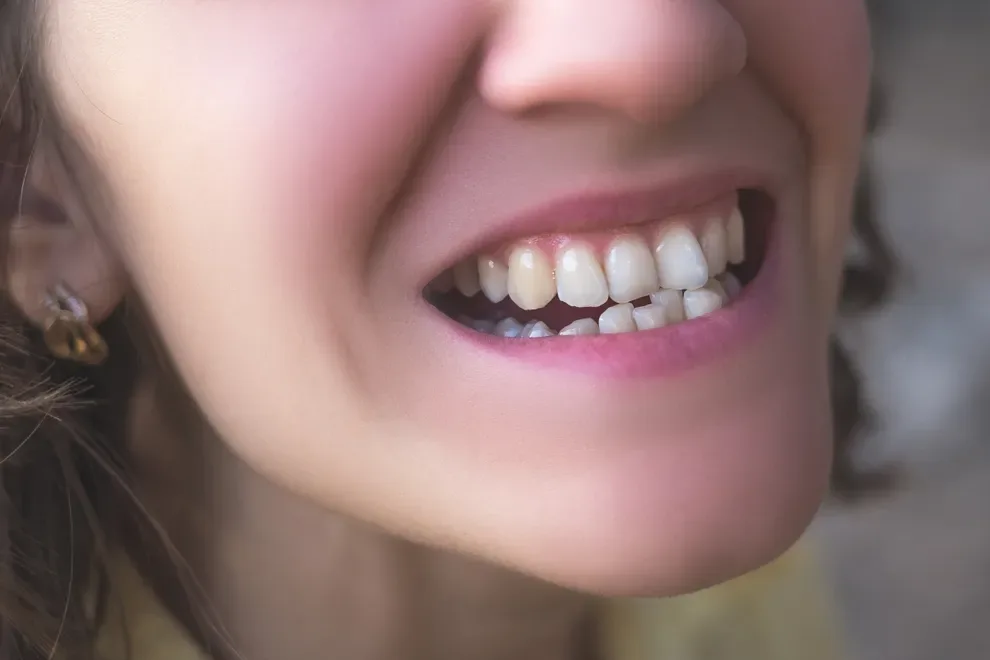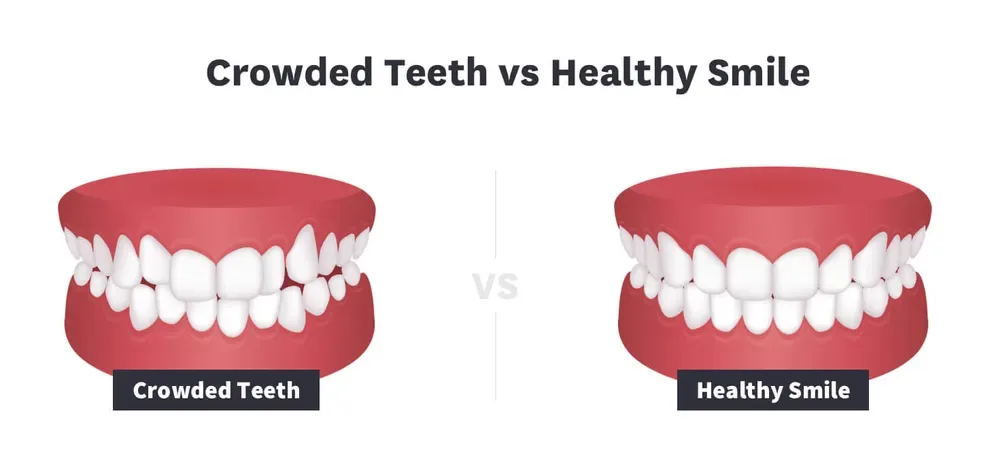Crowded Teeth: How Do I Get Dental Crowding Properly Fixed?

Table of Contents
- What is Dental Crowding?
- Crowded Teeth Grades
- Teeth Crowding Causes
- Signs of Crowded Teeth
- Crowded Teeth Health Risks
- Crowded Teeth Treatment
- Can Byte Treat Crowded Teeth?
- Crowded Teeth FAQs
- References
All cases of crowded teeth are different. Some are more serious than others. Sometimes, the best way to fix crowded teeth is to work with a dentist and orthodontist on a series of extractions, spacers, and braces.
But sometimes, crowded teeth can be fixed at home with aligners. You'll still need a dental expert to supervise your progress, but this method could save you time and money.

What is Dental Crowding (or crowded teeth)?
The Farlex Partner Medical Dictionary defines crowding as a condition in which the teeth are so crowded that they bunch, overlap, or twist.
In a healthy mouth, the sides of all teeth touch. In a mouth with dental crowding, some teeth are too far forward, back, or sideways.
Are There Different Grades of Crowded Teeth?
Dentists can help you determine just how crowded your teeth are. The more severe your case, the more significant treatment you might need.
Just one or two teeth overlap or are slightly out of position. People might notice this if they look closely, but others don't see it at all.
Several teeth overlap or are out of position. Some might cross over one another to such a degree that flossing is tough, and you might get food trapped between teeth.
Your teeth are pushed tightly together, making flossing and brushing difficult. The problem is easy to spot right away.
What Causes Teeth Crowding?
Teeth can be crowded together for various reasons, and some can't be controlled.
Teeth can crowd due to the following:
Heredity: Genes are responsible for most cases of tooth crowding, experts say. If most of your family photos show smiles marred by crowding, you will likely deal with the same problem too.
Illness and injury: If you're hit in the face, your jaw can move out of alignment and change the position of your teeth. Some mouth and jaw tumors can also shift tooth placement.
Childhood habits: Prolonged bottle feeding or thumb sucking can contribute to tooth crowding.
Poor dental care: Loose or missing teeth, improperly fitting crowns, and more can all cause changes in tooth position.
Changing teeth: Losing your baby teeth early, growing extra teeth, or having teeth that are too large could cause crowding.
What are the Signs of Crowded Teeth?
If you have crowded teeth, you may notice the issue when you look in the mirror. But you may also have subtle signs that indicate your teeth aren't nesting together as they should.
Crowded teeth signs include the following:
Difficulty cleaning your teeth: Floss gets stuck and breaks. And bristles from your toothbrush stick between your teeth.
Stuck food: After you eat, tiny bits of food stick in the crowded spots.
Advanced decay: Some experts believe that crowding can lead to cavities. It's hard to clean hidden spots, and that can make your oral health worse.
Whistling sounds: Air can move in unusual ways through your teeth when you talk, leading to strange noises.
Can Crowded Teeth Cause Health Risks?
Significantly crowded teeth can cause the following problems:
When your jaw is too small to hold the teeth it has now, there's no room for new teeth. If you have more teeth coming in, like wisdom teeth, they can be lodged in your jaw when they can't find space. This condition is called impaction, experts say, and it can be very painful.
Researchers say that crooked teeth are more prone to injury. If your teeth twist outside of your lips, it's easier for them to get scraped or pushed aside during sports, eating, and other routine activities.Straight teeth can be harmed too, but researchers say crooked teeth have a higher risk of problems.
Researchers say that adolescents with crooked or crowded teeth have low levels of self-esteem. That's especially true of adolescent girls.It's hard to look in the mirror and see what are perceived as flaws. For young people, straightening crowded teeth is the best way to feel better about the way they look.
Regular brushing and flossing keep bacteria and plaque from building up on teeth. But crowded teeth offer plenty of spots for food and waste to hide, and that can lead to problems you can't address with routine dental care.
Jaws misaligned by crowded teeth don't fit together with ease, and that means jaw muscles and tendons must work harder to complete routine tasks like biting, chewing, and talking.
It's common for people to talk about crowded teeth as a cosmetic issue. But clearly, teeth that are bunched together can lead to a variety of secondary problems. Many of them have little to do with appearance at all.
How Do Dentists Treat Crowded Teeth?
In a healthy mouth, your upper and lower jaws nest together. When something ruins that close relationship, experts refer to the issue as malocclusion. In severe cases, it can cause significant health issues.
If you've been assessed by a dentist or orthodontist, and you know you have severe malocclusion, you might need an expert's help to get better. They may use the following treatment approaches:
In severe cases of crowding, doctors may need to remove some teeth to make room for others. This is a significant step, and it isn't always necessary.
Young children might benefit from this help. If a dentist can remove baby teeth and allow adult teeth to break through, the child may have fewer crowding issues.
Young kids may also benefit from devices that shift the jaw into the right position. The device is typically worn during growth spurts, dentists say, and it slowly widens or moves the jaw to ensure that the two parts nestle together properly.
After teeth are removed or jaws are shifted, those crowded teeth must be pushed into the proper places. And often, this is a significant correction. Big gaps can remain after teeth are pulled. Sometimes, the remaining teeth are twisted or turned.
Orthodontists glue brackets onto the teeth, and they connect all the teeth with wires. The wires get shorter and shorter in a series of appointments. Customers can't make these shifts on their own. They must visit the office to complete the work.
Braces can be quite expensive. It's not uncommon for customers to spend $5,000 or more. And most people who have braces must wear them for years to fix crowded teeth.
Clear plastic trays snap onto your teeth and apply gentle pressure to shift teeth into position. Treatment plans move quickly, so you're back to a clear smile in no time. And you can remove the trays for cleaning, so your risk of cavities is reduced.
Clear aligners are appropriate for mild-to-moderate cases of crowded teeth. If your problem is severe, you might need a different type of care.
Dentists glue tooth-colored plates to the front of your teeth. They could place them over the gaps in your teeth and cover the problem in no time.
Veneers are durable and quick, but if you drink lots of coffee and tea, they could be discolored.
After treatment, people must wear retainers to protect their investment, and those devices should be part of their daily routines for the rest of life.
Can Byte Fix my Crowded Teeth?
Imagine that only a few crowded teeth mar your smile. Maybe they're bunched right up in the center, where everyone can see them. Perhaps you can feel them when you run your tongue over your smile. You can fix minor tooth crowding like this at home.
Doctor-monitored, at-home aligners put you in touch with a team of dental experts. They will do the following:
Assess your smile. You’ll send in impression from your at-home dental impression kit, so they can assess how your teeth look now.
Plan for the future. A doctor looks over the impressions and determines how your teeth should move.
Create aligners. Your team makes a series of plastic trays that slide over your teeth. Periodically, you swap out these trays for new sets. Slowly, your teeth take up new positions. Experts say aligners can move your teeth about 0.3 millimeter per tray.
Telemedicine techniques keep you in touch with your treatment team. You still have appointments with an expert, but they're done online.
This medicine model cuts expenses, meaning aligners often come with smaller price tags. You might pay $2,000 for aligners, which is less than half of what you might pay for braces.
Aligners can also work quickly when compared to braces. If your crowding issue is mild, you may only need the tools for a few months, not years.
Crowded Teeth Frequently Asked Questions
Your dental team can help you straighten teeth and improve your smile. Plenty of treatment options exist, and your team can help you find the one that's right for you.
Many people have crowded teeth, although some cases are easier to spot than others. If your crowded teeth are right in front of your smile, most people will see them.
Not necessarily. Some cases of teeth crowding are stable and don't change with time. Others, including crowding caused by illness, can worsen over time.
It depends. Mild cases addressed with aligners can be fixed within a few months, while more severe cases will take longer to address.
Some people notice a persistent, deep pain in the jaw from teeth rubbing and scraping. Some notice pain when they brush or floss. But some people don't notice any feelings associated with crowded teeth.
It depends. If your teeth are crowded due to an injury, they could fall out. And if your dental hygiene suffers, your wounded teeth may fall out. But plenty of crowded teeth stay rooted and never fall out.
